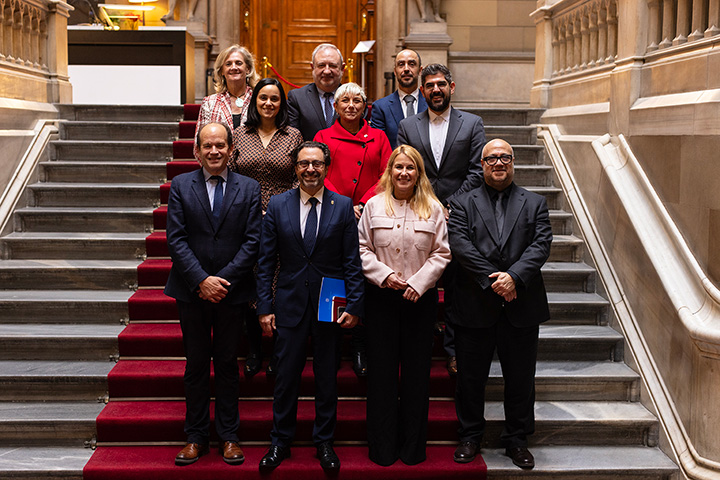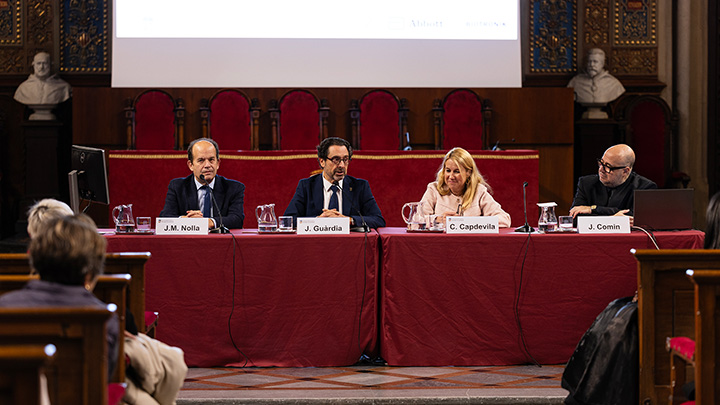The UB, Bellvitge Hospital, Biotronik, Abbott and AstraZeneca create a pioneering chair in cardiovascular simulation


Josep Comín, cardiologist and director of the UB Hospital de Bellvitge Chair of Cardiovascular Simulation, points out that the project stands out for "the access to advanced technological resources, the great clinical experience of the Heart Diseases Area of the Bellvitge University Hospital and the teaching capacity of the UB’s Bellvitge Campus".
This year, clinical simulation has played an important role in health sciences education, given its effectiveness in providing an accurate assessment of students' skills. Specifically, this project is in addition to the first chair in robotic surgery in Catalonia, created in 2021 thanks to the alliance between the UB, the Bellvitge University Hospital and the company Abex Excellence Robotics.
Advanced technological resources and equipment of excellence
The Chair combines different methodologies: from the recreation of clinical scenarios by computer, using specific software, to the realistic simulation of interventional electrophysiology, endovascular or surgical procedures, thanks to wet lab technology, which faithfully reproduces punctures, pacemaker and catheter implantations and other interventions. It also includes the use of simulator mannequins, interactive and audiovisual resources in three dimensions, virtual and augmented reality, online training platforms and other disruptive technological resources.
To guarantee the success of the project, the Bellvitge University Hospital has the best infrastructure. The Advanced Medical-Surgical Simulation Centre (SimHUB) is a new 500 m2 facility of excellence in which clinical processes and highly complex procedures can be recreated in environments comparable to the real ones. It also has eight rooms that reproduce real practice scenarios and three multifunctional spaces that include briefing rooms, remote simulation and supervision of trainees.
Synergies with key industrial partners
The vocation of the project is to be a leader in training excellence, so that this translates into an improvement in the quality of care and the sustainability of the health system, through the safe learning of health professionals. The leadership that has emerged from the strategic alliance between the UB and the Bellvitge University Hospital is complemented by the participation of AstraZeneca, Biotronik and Abbott, leading industrial partners in the cardiovascular field.
In his speech, the rector of the UB, Joan Guàrdia, stressed that one of the University's principles is to "go from beginning to end". "We pay attention from artistic creation to the last molecule we are synthesising. In this sense, this chair highlights the importance of collaboration between universities, hospitals, research centres and the productive sector. It is a perfect equation that results in a Catalan research, care and academic system of the highest order", said the rector.
David Carrero, senior technical and education advisor at Biotronik, said that "simulation is the main vehicle for learning". "We create scenarios in safe environments so that professionals can assimilate knowledge through simulation and then apply it to real life. With simulations we make learning permanent", he remarked.
For her part, Lydia Roca, general manager of Abbott Vascular Iberia, highlighted "innovation, education and support for research" as pillars of her company. "At Abbott, we want to make an impact on healthcare to contribute to greater safety in patient care, improving their lives and contributing to a more efficient and sustainable healthcare system," she said.
César Velasco, director of Innovation and Digital Strategy at AstraZeneca, reaffirmed his company's "passion for innovation and learning". "We want to bring our innovative vision to permeate all healthcare professionals and thus have a positive impact on the patient", he stated.
The event was also attended by Cristina Capdevila, territorial manager of the Southern Metropolitan Area of the Catalan Institute of Health, and Joan Miquel Nolla, academic vice-dean of the Faculty of Medicine and Health Sciences of the Bellvitge Campus.
Cardiovascular diseases
Cardiovascular diseases are the leading cause of death in western countries. Moreover, due to the ageing of the population, their prevalence is expected to increase in the coming decades, posing a threat to people's quality of life and to the sustainability of the healthcare system.
In this context, there has been an exponential growth in the need for knowledge and practical skills of healthcare professionals in the care and prevention of cardiovascular diseases, together with the need to promote increasingly technological medicine and tertiary-oriented training of specialists in cardiology or cardiac surgery.
Multimedia gallery

